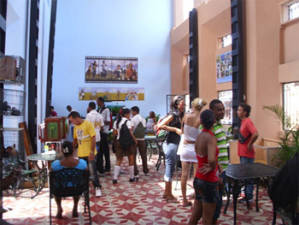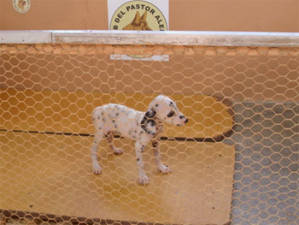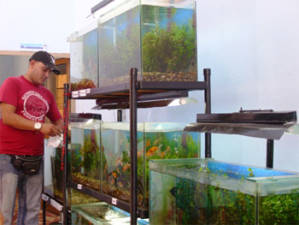Pets and Pretensions
Janis Hernandez
 HAVANA TIMES — Cubans have one personality trait that’s almost inherent: being presumptuous and vain. Though they live in a Third World country with a fragile economy, they’ve always aspired to a standard of living higher than their real possibilities.
HAVANA TIMES — Cubans have one personality trait that’s almost inherent: being presumptuous and vain. Though they live in a Third World country with a fragile economy, they’ve always aspired to a standard of living higher than their real possibilities.
They like to dress well, eat good food and have a bit of comfort in their homes, and to maintain these, more than a few sacrifices are made daily on the island.
 This has led some people to engage in all types of illegal activities, even those that are morally corrupt. Likewise, many depend on remittances from family, friends or lovers abroad in order to maintain a “certain status.”
This has led some people to engage in all types of illegal activities, even those that are morally corrupt. Likewise, many depend on remittances from family, friends or lovers abroad in order to maintain a “certain status.”
We might agree that eating and dressing are basic needs, and creature comforts in one’s home are also priorities. Nevertheless, I believe there are certain eccentricities that only rich people in a many parts of the world can afford.
 One of these is the purchasing and caring for certain pets. While it’s true that in most homes there have always been beloved domesticated animals, people never showed much of an interest in the particular breeds of these creatures.
One of these is the purchasing and caring for certain pets. While it’s true that in most homes there have always been beloved domesticated animals, people never showed much of an interest in the particular breeds of these creatures.
Dogs, cats and fish were traditionally the most common pets in Cuba; but for some time now, other household pets have become popular, ones such as hamsters, squirrels and exotic birds.
So-called mutts and alley cats have been forgotten and left in the streets.
 Their low class lineages don’t allow them to compete with the bulldogs, cocker spaniels, Dalmatians, Dobermans, German Shepherds and White Swiss Shepherds, Saint Bernards, Rottweilers, schnauzers or Afghan hounds. Similarly, stray tomcats can’t compare with the Angoras, Abyssinian or Siamese cats that are sold here.
Their low class lineages don’t allow them to compete with the bulldogs, cocker spaniels, Dalmatians, Dobermans, German Shepherds and White Swiss Shepherds, Saint Bernards, Rottweilers, schnauzers or Afghan hounds. Similarly, stray tomcats can’t compare with the Angoras, Abyssinian or Siamese cats that are sold here.
In many parts of the country there are places that sell these kinds of pets. The funny thing is to see how they’re sold for sky high prices here in a country where the wages of most people are less than a dollar a day.
Plus, it goes without saying that these animals require certain foods and care, especially given the fact that many of these breeds have to adapt themselves to our tropical climate.
 On the other hand, I find it a little annoying to see how they’re put on display in cages until the highest bidder comes to take them away. In Santiago de Cuba, they recently opened a pet store like this where they sell dogs, cats, mice, hamsters, birds and fish.
On the other hand, I find it a little annoying to see how they’re put on display in cages until the highest bidder comes to take them away. In Santiago de Cuba, they recently opened a pet store like this where they sell dogs, cats, mice, hamsters, birds and fish.
These luxuries that some Cubans currently enjoy, accentuate our social differences. I witnessed a family that bought a Dalmatian for their child — for 35 CUCs (close to $40 USD) — while a few feet away a man was begging for spare change.
Many people will respond to this commentary with the old saying: “To whom God gave it, may they enjoy it…” and I won’t deny that. But loving animals must go beyond whatever breed they might be or how much they cost. Liking pets is one thing while suffering from certain pretensions is another.






Its jan 2022. Cute little havanese dogs are in short supply. Look up all dog rescue foundationsions and little apt dogs that dont shed are impossible to find. I found some puppies for $1500.00. No more boat loads of people or drugs..boat loads of cute stray dogs for $100.00 each. I want one please. Two of my favorite foundations in Las Vegas are above. Maybe somthing can be done. The demand is here. The supply is there. Dont let the embargo stop this solution. animalfoundation.org & heavencanwaitlv.org
13 is OLD? 22 is getting up there. Poor Cuban cats.
Hello Janis,
Nice article, a welcome relief from the doom and gloom writing about Cuba that we see a lot of on HT. I can hear folks thinking, hey, it can’t be as awful as some paint it out to be if Cubans can afford to keep pets.
I have a Cuban pet story I can share with you. We, my wife and I, travel with our cat who came with us to Cuba. It involved some paperwork but it was a pleasant experience and meaningful, not just make-work paperwork.
The Cuban government is incredibly health-focused as everyone knows. A veterinarian inspected our cat but he was looking for possible health threats to humans more than our cat’s health. So, when the cat developed an ingrown claw that became infected during our stay, we were concerned about who to get to have it looked after. I emailed our vet in Toronto asking if they had any contacts in Cuba, thinking we might have to go to Havana for treatment.
Our vet wrote back telling us what equipment and medicine was needed and the procedure to follow but she had no suggestions about who to contact. Remembering that vets are used by customs and immigration, I got in touch with the nearest office. Our cat was looked after immediately and the treatment was state of the art – better than what we have seen in Toronto.
They insisted we bring the cat back in a few days to see how she was doing. And there was no charge for anything. I obviously made an instant CUC remittance – recognising the need for government employees to supplement their income. Actually, the practice is not all that unusual in Latin America.
When I was in the Galapagos which is highly controlled for visitors to protect the wildlife, I wanted to stay a bit longer than my visa allowed. Locals told me officials would look after it for a ‘stipend’. I balked at bribing an officia but was told the Ecuadorian government pays their officials a minimum salary and it was expected they would find ways to supplement it.
I am still getting enquiries by email from the Cuban vet asking how our cat is doing. She’s getting on – 13 years old. Cubans were amazed. They had never seen a cat that lived so long!
I’ll check with Purina Pet Foods and see how fast they can load up a boatload of pet food for shipment to Cuba the minute the US ends its ridiculous blockade.
The price of dog food in Cuba is nearly double what it costs in the US. I am talking about the supermarket brands. The brands you can only find in the pet stores aren´t even available in Cuba and only a couple of the supermarket brands. As a result, most pet owners in Havana resort to table scraps for their dogs. Vets have long rejected the nutritional value of human food for our house pets. I feel sorry for most of the dogs and cats I see in Cuba as most of them have to fend for themselves on the streets. Finally, although they exist, there are very few animal protection officers in Cuba and I have never seen anyone held to account for the countless acts of animal cruelty and neglect I have witnessed. It is tough to be Cuban in Cuba these days, even tougher to be a dog.
Interesting article. I was fascinated with the dogs of Cuba. Not the fancy breeds, but the ones I saw on the streets every day. If my health improves, I’d like to go back to Cuba to photograph the street dogs and their owners.
One Parador in Cienfuego had a pet dog named Yetti. I would turn him loose so I could scratch his ears and visit with him, till we got caught, and scolded. Him because he couldn’t resist chasing the neighbors cat and me, because I knew we’d both be in trouble – again. Yetti is one of the ugliest dogs I’ve ever seen, but he is dearly loved by his family.
I saw dogs begging on San Rafael, who were so well behaved I was never sure if they were pets or strays. Their behavior was perfect. A nice Sit! Stay! far enough away from the tables not to be offensive. Clearly they were waiting their share of the bounty, whether from owner or stranger.
I was enchanted by the Tres Guerillas who were working for their owner’s by posing for photos and being paid by tourists like me. I think they more than paid for their up-keep.
I raised and showed dogs for years. I strongly recommend that anyone looking for a puppy, whether in Cuba, or elsewhere, go to a few dog shows and talk to the fanciers [after they come out of the ring]. These people breed dogs to improve the breed, if they are responsible. you can see several different breeds, and talk to people who know about their health problems and dispositions. Many of these people have retired Show Dogs or prospects who didn’t work out, that need good homes. Show breeders cannot keep all their pups simply because of time, space, and cost. To keep a special puppy means some one has to leave. I usually chose close friends or family to adopt my good friends, but bigger breeders cannot be as selective.
Pet Store Puppies are often raised in poor conditions and the Breeders only want the money. Never buy any puppy if you cannot see the parent’s, and the home they come from. Pups also should be 10-12 weeks old before they leave Mom. She teaches them good bath-room habits, bite inhibition, and many other things they don’t learn if they are sold as soon as they are weaned.
Dogs aren’t disposable, and shouldn’t be bought on a whim. They live 10 to 15 years, and deserve the same love and loyalty they shower on their owner.
The pet business you describe, Janis, seems like the one that exists up here in the US–although up here I’m sure it is on a much grander scale.
One thing we have come to realize is that our socialist cooperative movement’s struggle for a single-payer national healthcare system should include such insurance for animals–both domestic pets and strays, and farm animals of all types.
With thousands of beautiful, but homeless, animals needing human intervention, it is OBSCENE that anyone buys a companion (pet) animal. The straggly dog or cat today will be gorgeous in a short period of time with the right care and oten some medical intervention. It’s the least we can do for our best friends!